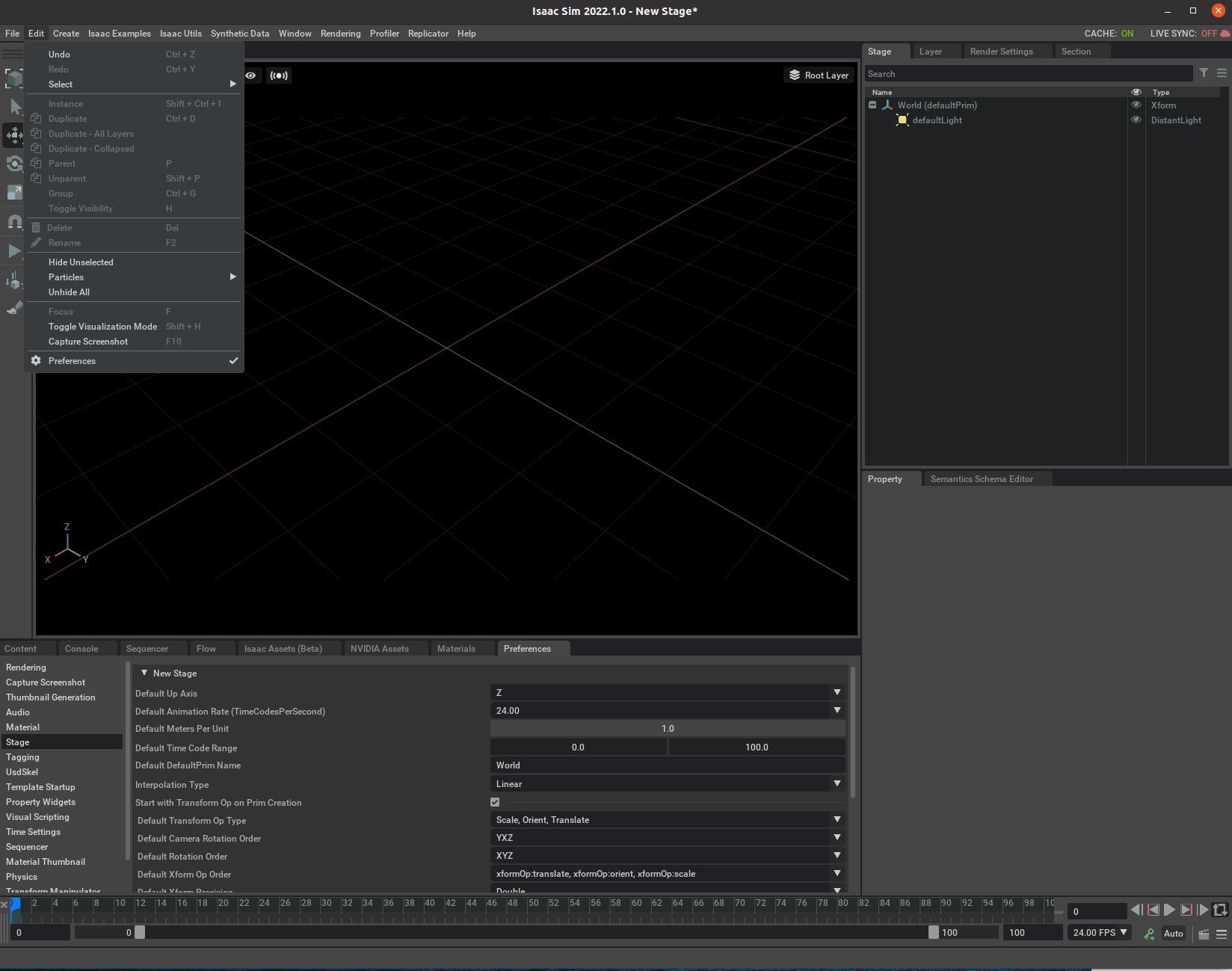2.1. Environment Setup
Omniverse Isaac Sim is built on NVIDIA Omniverse using tools provided in Omniverse Kit. Omniverse Kit comes with a default UI that allows the user to edit a USD stage with ease. In this tutorial series, we will go over the basic steps for setting up an environment, adding and editing simple objects and their properties on a USD stage, rigging rigid bodies with joints and articulations, and adding cameras and sensors. At the end of the series, you should have the basic skill to navigate Omniverse Isaac Sim, become familiar with frequently used terms, and be able to build an environment and set up your robots via the graphical interface.
2.1.1. Learning Objectives
This tutorial details how to build a physics-enabled virtual world using the tools provided in the Omniverse Isaac Sim GUI. We will cover how to
Setup global stage properties
Setup global physics properties
Add ground plane
Add lighting
2.1.2. Getting Started
Prerequisites
Review the Isaac Sim Interface tutorial prior to beginning this tutorial.
Let’s start with the clean stage provided at the opening of Omniverse Isaac Sim. If you have already added objects to your stage, go to the File menu and click on New. The stage provided to you has a default World Xform, and a defaultLight. Both can be found on the stage tree on the left under the Stage tag.
2.1.3. Setting up Stage Properties
Before anything is added onto the stage, it’s a good idea to first check if the current stage property setup matches the conventions that you are expecting. Go to Edit > Preferences to open up the Preference panel. Here you can browse the many types of setting inside Omniverse Kit grouped into categories in the column on the left of the panel. Select Stage from the left column. Here you can examine properties such as:
The axis that determines Up. The default in Omniverse Isaac Sim is Z. If your asset is created in a program with a different up-axis, it will cause your assets to be imported rotated.
Stage units. Omniverse Isaac Sim versions prior to 2022.1 have stage units in centimeters, but the default is now meters. However, the default units for Omniverse Kit is still in centimeters. Keep that in mind if you see USD units that are seemingly off by 100x.
Default rotation order. The default is set so that it will execute rotation in X first, then Y, and last Z.

2.1.4. Creating the Physics Scene
We will start by adding a Physics Scene to provide the general physics simulation properties to the world, such as gravity and physics time steps. Go to the Menu Bar and click Create > Physics > Physics Scene. A PhysicsScene should be added to the stage tree. Click on it to examine its properties. You can see that gravity is set to point at the -Z direction with a magnitude of 9.8, a reminder that the default unit of length is meters. Unless you are simulating hundreds of rigid bodies and robots, it is more efficient to use a CPU solver instead of GPU, so for the purpose of this tutorial, disable GPU dynamics and use MBP Broadphase inside the Physics Scene’s Property tab.
2.1.5. Adding a Ground Plane
Next, we will add a ground plane to the virtual environment. The ground plane will prevent any physics-enabled objects from falling below it. Go to the top Menu Bar and Click Create > Physics > Ground Plane. The ground plane’s collision property extends indefinitely even though the plane is only visible up to 25 meters in each direction. Turn on the grid to make the ground plane easier to see.
2.1.6. Lighting
Every new Stage is pre-populated with a defaultLight — otherwise you wouldn’t see anything. But let’s create an additional spotlight as an exercise.
Add a ground plane if there isn’t already one, so we can see the reflection of the light. Create > Physics > Ground Plane.
Go to Create > Light > Sphere Light.
Move it up and turn it face down by moving it 7 units up and void the rotation in X and Y axis.
Inside the Property Tab, change its color in Main > Color by simply clicking on the color bar and pick a color of your choice.
Change its intensity Main > Intensity to 1e6; Main > Radius to 0.05, Limit the scope of the spot in Shaping -> cone:angle to 45 degrees, and soften the edge of the spotlight in Shaping -> cone:softness to 0.05.
To make the new spotlight easier to see, we will reduce the intensity of the default light by going to its Property tab and set Main > Intensity to 300.
2.1.7. Summary
This tutorial begins the series of steps to create a virtual world suitable for physics simulation and testing Omniverse Isaac Sim. The following topics were covered:
Adding a ground plane, lighting, and physics scene.
2.1.7.1. Next Steps
Continue on to Add Simple Objects to learn how to add simple objects to Omniverse Isaac Sim and edit their properties.
2.1.7.2. Further Learning
For more in-depth and creative world-building tools, refer to our sister Omniverse tool Composer.